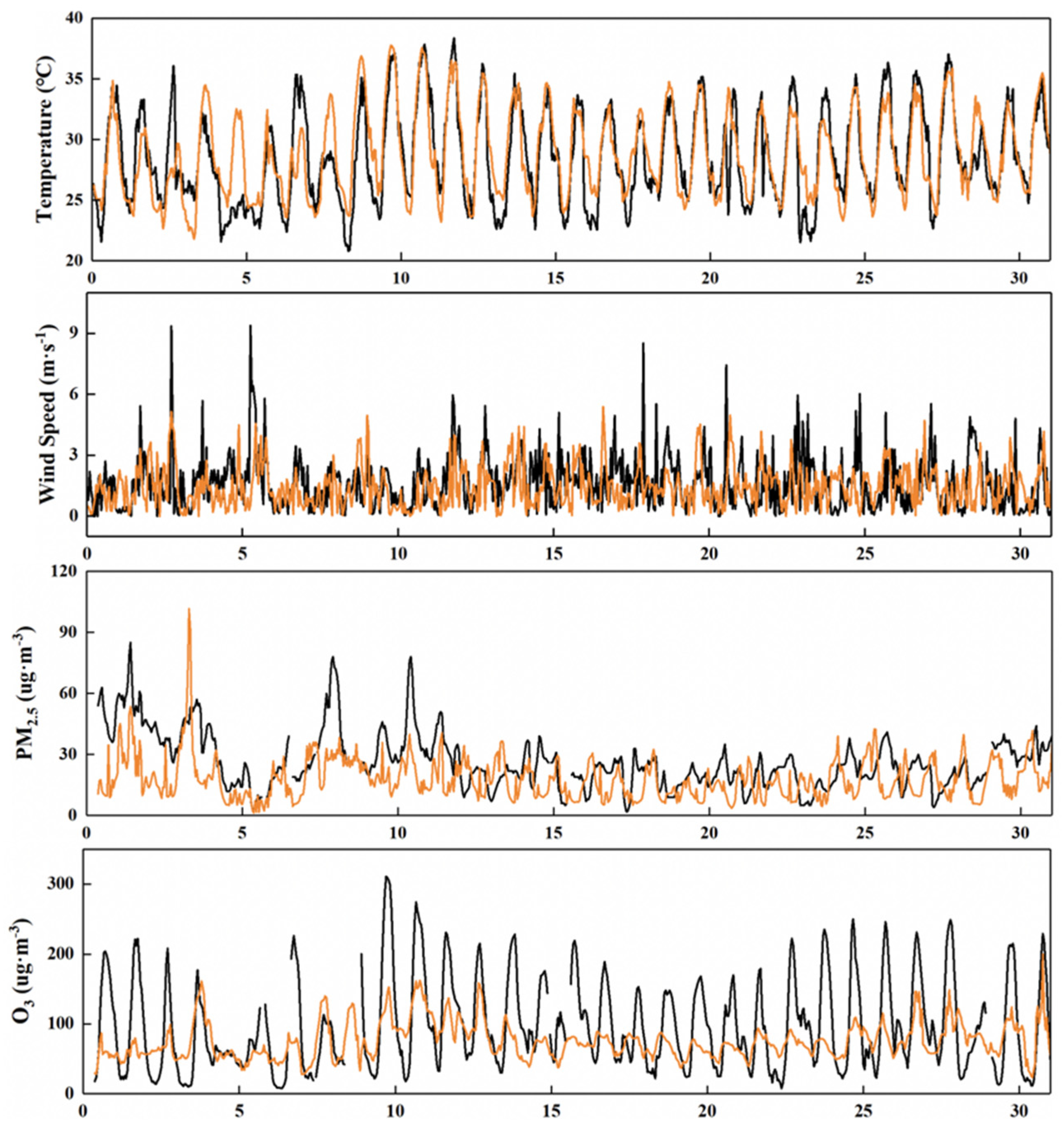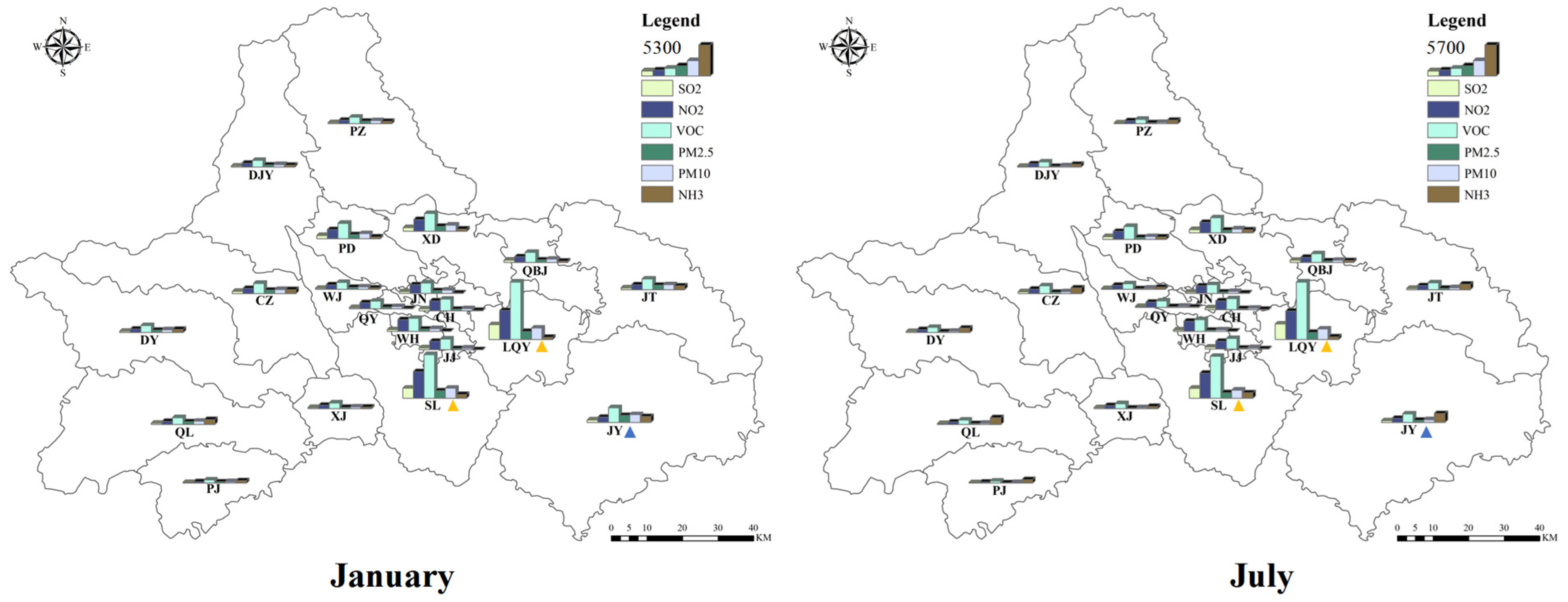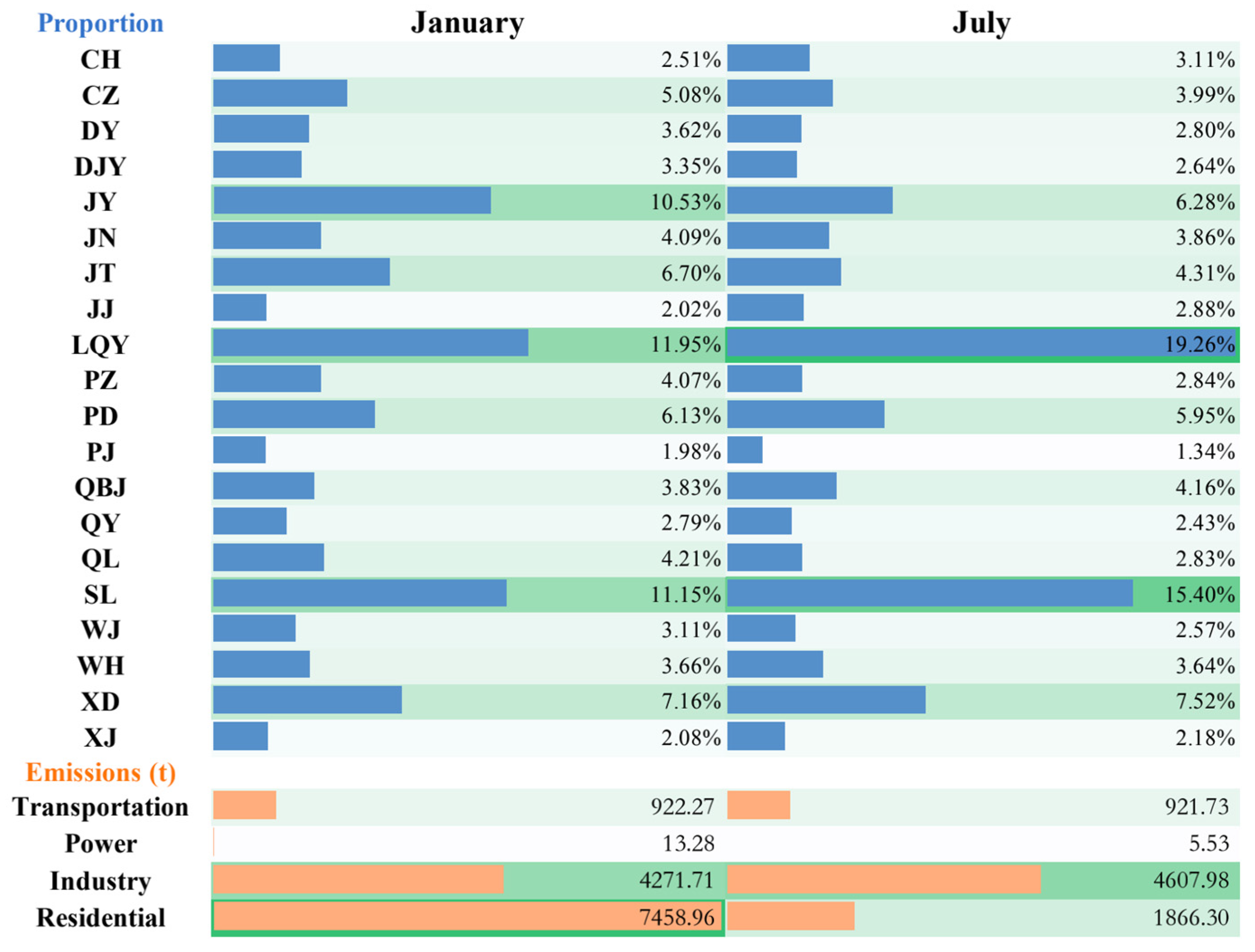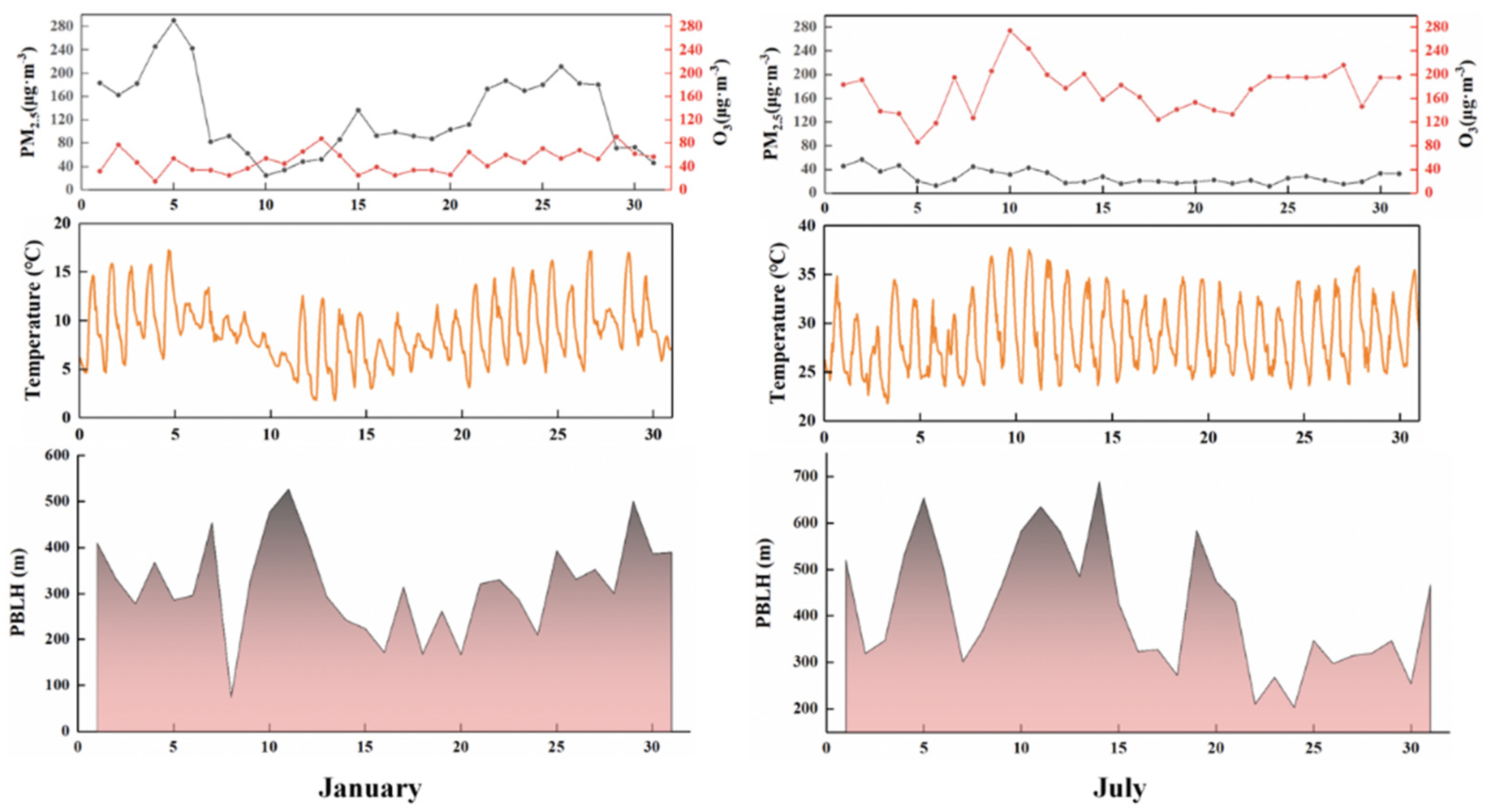Characteristics of Air Pollutants Emission and Its Impacts on Public Health of Chengdu, Western China
Abstract
:1. Introduction
2. Data and Methods
2.1. WRF-CMAQ Model and the Study Area
2.2. Environmental Health Impact Assessment
2.3. Economic Valuation of the Health Impacts
3. Results
3.1. Model Validation
3.2. Spatial Distribution of Pollutant Emission
Source and Distribution of PM2.5
3.3. Variation in Pollutant Concentration
3.4. Health Burden
3.5. Economic Losses
4. Conclusions
Author Contributions
Funding
Informed Consent Statement
Data Availability Statement
Acknowledgments
Conflicts of Interest
References
- Chen, Y.; Li, H.; Karimian, H.; Li, M.; Fan, Q.; Xu, Z. Spatio-temporal variation of ozone pollution risk and its influencing factors in China based on Geodetector and Geospatial models. Chemosphere 2022, 302, 134843. [Google Scholar] [CrossRef] [PubMed]
- Edlund, K.K.; Killman, F.; Molnar, P.; Boman, J.; Stockfelt, L.; Wichmann, J. Health Risk Assessment of PM2.5 and PM2.5-Bound Trace Elements in Thohoyandou, South Africa. Int. J. Environ. Res. Public Health 2021, 18, 1359. [Google Scholar] [CrossRef] [PubMed]
- Lee, J.K.; Kwak, M.J.; Jeong, S.G.; Woo, S.Y. Individual and Interactive Effects of Elevated Ozone and Temperature on Plant Responses. Horticulturae 2022, 8, 211. [Google Scholar] [CrossRef]
- Li, Y.; Liao, Q.; Zhao, X.-G.; Bai, Y.; Tao, Y. Influence of PM2.5 Pollution on Health Burden and Economic Loss in China. Huan Jing Ke Xue Huanjing Kexue 2021, 42, 1688–1695. [Google Scholar] [CrossRef] [PubMed]
- Wu, Y.; Yang, X.; Wang, H.; Jia, G.; Wang, T. Relationship between ambient PM2.5 exposure and blood cadmium level in children under 14 years in Beijing, China. J. Hazard. Mater. 2021, 403, 123871. [Google Scholar] [CrossRef] [PubMed]
- Liu, S.; Tian, H.; Luo, L.; Bai, X.; Zhu, C.; Lin, S.; Zhao, S.; Zhang, K.; Hao, J.; Guo, Z.; et al. Health impacts and spatiotemporal variations of fine particulate and its typical toxic constituents in five urban agglomerations of China. Sci. Total Environ. 2022, 806, 151459. [Google Scholar] [CrossRef]
- Bai, R.; Lam, J.C.K.; Li, V.O.K. A review on health cost accounting of air pollution in China. Environ. Int. 2018, 120, 279–294. [Google Scholar] [CrossRef]
- Feng, S.; Gao, D.; Liao, F.; Zhou, F.; Wang, X. The health effects of ambient PM2.5 and potential mechanisms. Ecotoxicol. Environ. Saf. 2016, 128, 67–74. [Google Scholar] [CrossRef]
- Jin, X.; Holloway, T. Spatial and temporal variability of ozone sensitivity over China observed from the Ozone Monitoring Instrument. J. Geophys. Res.-Atmos. 2015, 120, 7229–7246. [Google Scholar] [CrossRef]
- Liu, S.; Zhang, Y.; Ma, R.; Liu, X.; Liang, J.; Lin, H.; Shen, P.; Zhang, J.; Lu, P.; Tang, X.; et al. Long-term exposure to ozone and cardiovascular mortality in a large Chinese cohort. Environ. Int. 2022, 165, 107280. [Google Scholar] [CrossRef]
- Li, X.-B.; Fan, G. Interannual variations, sources, and health impacts of the springtime ozone in Shanghai. Environ. Pollut. 2022, 306, 119458. [Google Scholar] [CrossRef]
- Faridi, S.; Shamsipour, M.; Krzyzanowski, M.; Kunzli, N.; Amini, H.; Azimi, F.; Malkawi, M.; Momeniha, F.; Gholampour, A.; Hassanvand, M.S.; et al. Long-term trends and health impact of PM2.5 and O-3 in Tehran, Iran, 2006-2015. Environ. Int. 2018, 114, 37–49. [Google Scholar] [CrossRef] [PubMed]
- Lei, R.; Nie, D.; Zhang, S.; Yu, W.; Ge, X.; Song, N. Spatial and temporal characteristics of air pollutants and their health effects in China during 2019-2020. J. Environ. Manag. 2022, 317, 115460. [Google Scholar] [CrossRef] [PubMed]
- Liu, J.; Yin, H.; Tang, X.; Zhu, T.; Zhang, Q.; Liu, Z.; Tang, X.; Yi, H. Transition in air pollution, disease burden and health cost in China: A comparative study of long-term and short-term exposure. Environ. Pollut. 2021, 277, 116770. [Google Scholar] [CrossRef] [PubMed]
- Xiao, Q.; Geng, G.; Xue, T.; Liu, S.; Cai, C.; He, K.; Zhang, Q. Tracking PM2.5 and O3 Pollution and the Related Health Burden in China 2013–2020. Environ. Sci. Technol. 2022, 56, 6922–6932. [Google Scholar] [CrossRef]
- Zhang, J.; Chen, Q.; Wang, Q.; Ding, Z.; Sun, H.; Xu, Y. The acute health effects of ozone and PM2.5 on daily cardiovascular disease mortality: A multi-center time series study in China. Ecotoxicol. Environ. Saf. 2019, 174, 218–223. [Google Scholar] [CrossRef]
- Hu, J.; Huang, L.; Chen, M.; Liao, H.; Zhang, H.; Wang, S.; Zhang, Q.; Ying, Q. Premature Mortality Attributable to Particulate Matter in China: Source Contributions and Responses to Reductions. Environ. Sci. Technol. 2017, 51, 9950–9959. [Google Scholar] [CrossRef]
- Ding, D.; Xing, J.; Wang, S.; Liu, K.; Hao, J. Estimated Contributions of Emissions Controls, Meteorological Factors, Population Growth, and Changes in Baseline Mortality to Reductions in Ambient [Formula: See text] and [Formula: See text]-Related Mortality in China, 2013-2017. Environ. Health Perspect. 2019, 127, 67009. [Google Scholar] [CrossRef]
- Lei, R.; Zhu, F.; Cheng, H.; Liu, J.; Shen, C.; Zhang, C.; Xu, Y.; Xiao, C.; Li, X.; Zhang, J.; et al. Short-term effect of PM2.5/O3 on non-accidental and respiratory deaths in highly polluted area of China. Atmos. Pollut. Res. 2019, 10, 1412–1419. [Google Scholar] [CrossRef]
- Xie, Y.; Dai, H.; Zhang, Y.; Wu, Y.; Hanaoka, T.; Masui, T. Comparison of health and economic impacts of PM2.5 and ozone pollution in China. Environ. Int. 2019, 130, 104881. [Google Scholar] [CrossRef]
- Li, M.; Liu, H.; Geng, G.; Hong, C.; Liu, F.; Song, Y.; Tong, D.; Zheng, B.; Cui, H.; Man, H.; et al. Anthropogenic emission inventories in China: A review. Natl. Sci. Rev. 2017, 4, 834–866. [Google Scholar] [CrossRef]
- Zheng, B.; Tong, D.; Li, M.; Liu, F.; Hong, C.; Geng, G.; Li, H.; Li, X.; Peng, L.; Qi, J.; et al. Trends in China’s anthropogenic emissions since 2010 as the consequence of clean air actions. Atmos. Chem. Phys. 2018, 18, 14095–14111. [Google Scholar] [CrossRef] [Green Version]
- Nie, D.; Shen, F.; Wang, J.; Ma, X.; Li, Z.; Ge, P.; Ou, Y.; Jiang, Y.; Chen, M.; Chen, M.; et al. Changes of air quality and its associated health and economic burden in 31 provincial capital cities in China during COVID-19 pandemic. Atmos. Res. 2021, 249, 105328. [Google Scholar] [CrossRef] [PubMed]
- Silva, R.A.; Adelman, Z.; Fry, M.M.; West, J.J. The Impact of Individual Anthropogenic Emissions Sectors on the Global Burden of Human Mortality due to Ambient Air Pollution. Environ. Health Perspect. 2016, 124, 1776–1784. [Google Scholar] [CrossRef] [Green Version]
- Shang, Y.; Sun, Z.; Cao, J.; Wang, X.; Zhong, L.; Bi, X.; Li, H.; Liu, W.; Zhu, T.; Huang, W. Systematic review of Chinese studies of short-term exposure to air pollution and daily mortality. Environ. Int. 2013, 54, 100–111. [Google Scholar] [CrossRef]
- Dong, J.; Liu, X.; Zhang, B.; Wang, J.; Shang, K. Meta-analysis of association between short-term ozone exposure and population mortailty in China. Acta Sci. Circum. 2016, 36, 1477–1485. [Google Scholar] [CrossRef]
- Huang, D.; Xu, J.; Zhang, S. Valuing the health risks of particulate air pollution in the Pearl River Delta, China. Environ. Sci. Policy 2012, 15, 38–47. [Google Scholar] [CrossRef]
- Peng, F.; Li, X.; Ma, D.; Zhou, Y.; Yu, F.; Zhang, Y.; Yang, W. Assessing the Value of a Statistical Life of Air Pollution in Chengdu Chongqing Area by Contingent Value Method with Single Bounded Dichotomy. Chin. J. Environ. Manag. 2021, 13, 136–141+111. [Google Scholar] [CrossRef]
- Wang, J.; Wang, S.; Voorhees, A.S.; Zhao, B.; Jang, C.; Jiang, J.; Fu, J.S.; Ding, D.; Zhu, Y.; Hao, J. Assessment of short-term PM2.5-related mortality due to different emission sources in the Yangtze River Delta, China. Atmos. Environ. 2015, 123, 440–448. [Google Scholar] [CrossRef]
- Diao, B.; Ding, L.; Zhang, Q.; Na, J.; Cheng, J. Impact of Urbanization on PM2.5-Related Health and Economic Loss in China 338 Cities. Int. J. Environ. Res. Public Health 2020, 17, 990. [Google Scholar] [CrossRef]
- Hu, J.; Chen, J.; Ying, Q.; Zhang, H. One-year simulation of ozone and particulate matter in China using WRF/CMAQ modeling system. Atmos. Chem. Phys. 2016, 16, 10333–10350. [Google Scholar] [CrossRef] [Green Version]
- Fang, C.; Qiu, J.; Li, J.; Wang, J. Analysis of the meteorological impact on PM2.5 pollution in Changchun based on KZ filter and WRF-CMAQ. Atmos. Environ. 2022, 271, 118924. [Google Scholar] [CrossRef]
- Yu, X.N.; Shen, L.; Hou, X.H.; Yuan, L.; Pan, Y.P.; An, J.L.; Yan, S.Q. High-resolution anthropogenic ammonia emission inventory for the Yangtze River Delta, China. Chemosphere 2020, 251, 126342. [Google Scholar] [CrossRef]
- Liao, W.; Liu, M.; Huang, X.; Wang, T.; Xu, Z.; Shang, F.; Song, Y.; Cai, X.; Zhang, H.; Kang, L.; et al. Estimation for ammonia emissions at county level in China from 2013 to 2018. Sci. China-Earth Sci. 2022, 65, 1116–1127. [Google Scholar] [CrossRef]
- Zheng, H.; Zhao, B.; Wang, S.; Wang, T.; Ding, D.; Chang, X.; Liu, K.; Xing, J.; Dong, Z.; Aunan, K.; et al. Transition in source contributions of PM2.5 exposure and associated premature mortality in China during 2005–2015. Environ. Int. 2019, 132, 105111. [Google Scholar] [CrossRef]
- Fang, C.; Wang, L.; Gao, H.; Wang, J. Analysis of the PM2.5 emission inventory and source apportionment in Jilin City, Northeast of China. Environ. Sci. Pollut. Res. 2020, 27, 37324–37332. [Google Scholar] [CrossRef]
- Liu, X.; Bai, X.; Tian, H.; Wang, K.; Hua, S.; Liu, H.; Liu, S.; Wu, B.; Wu, Y.; Liu, W.; et al. Fine particulate matter pollution in North China: Seasonal-spatial variations, source apportionment, sector and regional transport contributions. Environ. Res. 2020, 184, 109368. [Google Scholar] [CrossRef]











| NMB | NME | R | |
|---|---|---|---|
| T2 | 0.006055 | 0.379440 | 0.781 |
| U10 | −0.009600 | 0.789565 | 0.048 |
| PM2.5 | −0.606118 | 0.746895 | 0.463 |
| O3 | 0.409907 | 0.497384 | 0.457 |
| NMB | NME | R | |
|---|---|---|---|
| T2 | 0.017440 | 0.187526 | 0.799 |
| U10 | −0.139346 | 0.886220 | −0.005 |
| PM2.5 | −0.495627 | 0.726415 | 0.400 |
| O3 | −0.293757 | 0.596831 | 0.577 |
| Area | SO2 | NO2 | VOC | PM2.5 | PM10 | NH3 | ||||||
|---|---|---|---|---|---|---|---|---|---|---|---|---|
| January | July | January | July | January | July | January | July | January | July | January | July | |
| CH | 362.84 | 352.63 | 1837.83 | 1746.3 | 2142.11 | 2173.64 | 317.33 | 229.86 | 385.60 | 295.32 | 76.61 | 93.79 |
| CZ | 411.17 | 349.08 | 992.42 | 884.47 | 1882.10 | 1527.98 | 643.57 | 295.6 | 753.16 | 386.85 | 755.82 | 1132.72 |
| DY | 267.39 | 227.35 | 667.57 | 605.55 | 1298.13 | 1034.94 | 458.50 | 207.19 | 532.58 | 269.78 | 619.60 | 898.18 |
| DJY | 226.94 | 194.17 | 737.59 | 688 | 1267.57 | 1028.61 | 423.93 | 195.54 | 489.15 | 252.36 | 386.13 | 577.88 |
| JY | 485.79 | 349.07 | 998.13 | 842.46 | 2733.33 | 1689.08 | 1333.38 | 464.66 | 1469.92 | 561.1 | 1131.00 | 1793.86 |
| JN | 316.05 | 258.99 | 1627.17 | 1491.78 | 1936.17 | 1727.73 | 517.68 | 285.82 | 614.20 | 373.44 | 91.17 | 96.89 |
| JT | 340.29 | 257.07 | 919.50 | 821.11 | 1979.85 | 1362.59 | 848.87 | 319.1 | 943.85 | 390.39 | 720.80 | 1115.05 |
| JJ | 371.58 | 378.77 | 1593.35 | 1538.4 | 1991.42 | 2079.72 | 255.91 | 213.26 | 324.88 | 282.72 | 59.33 | 70.72 |
| LQY | 2744.09 | 3054.91 | 5375.36 | 5624.78 | 10628.14 | 11328.73 | 1513.24 | 1425.8 | 2119.62 | 2080.96 | 419.82 | 538.8 |
| PZ | 209.38 | 158.29 | 674.13 | 608.38 | 1232.13 | 877.41 | 515.10 | 210.53 | 583.39 | 266.34 | 461.81 | 734.48 |
| PD | 588.69 | 561.07 | 1695.12 | 1620.97 | 2858.39 | 2575.15 | 776.47 | 440.72 | 939.40 | 596.57 | 344.73 | 525.08 |
| PJ | 109.61 | 86.01 | 273.82 | 242.73 | 588.75 | 413.92 | 251.02 | 99.49 | 283.29 | 125.34 | 478.40 | 702.09 |
| QBJ | 409.09 | 407.01 | 1055.12 | 1029.7 | 1845.37 | 1716.33 | 484.60 | 307.96 | 607.43 | 430.99 | 241.07 | 362.92 |
| QY | 218.86 | 176.83 | 1146.26 | 1048.51 | 1420.53 | 1269.72 | 352.98 | 179.82 | 406.61 | 224.93 | 90.53 | 111.48 |
| QL | 227.57 | 175.44 | 584.84 | 515.94 | 1254.05 | 879.56 | 533.84 | 209.18 | 601.10 | 262.43 | 927.05 | 1333.8 |
| SL | 1869.86 | 1988.4 | 4947.65 | 4968.72 | 8092.08 | 8291.53 | 1412.34 | 1139.61 | 1874.20 | 1623.6 | 736.25 | 1101.61 |
| WJ | 215.41 | 185.35 | 869.13 | 820.68 | 1310.34 | 1106.12 | 393.76 | 189.87 | 454.47 | 243.25 | 292.75 | 457.08 |
| WH | 349.37 | 296.86 | 2202.87 | 2049.34 | 2431.32 | 2323.2 | 463.36 | 269.46 | 535.86 | 331.64 | 77.15 | 73.69 |
| XD | 668.57 | 636.46 | 2171.21 | 2085.58 | 3267.32 | 2972.39 | 907.06 | 556.5 | 1124.98 | 771.72 | 402.94 | 616.03 |
| XJ | 227.41 | 221.12 | 654.26 | 634.05 | 1069.88 | 1000.11 | 263.29 | 161.58 | 325.35 | 222.54 | 312.37 | 468.08 |
Publisher’s Note: MDPI stays neutral with regard to jurisdictional claims in published maps and institutional affiliations. |
© 2022 by the authors. Licensee MDPI, Basel, Switzerland. This article is an open access article distributed under the terms and conditions of the Creative Commons Attribution (CC BY) license (https://creativecommons.org/licenses/by/4.0/).
Share and Cite
Wang, J.; Li, J.; Li, X.; Fang, C. Characteristics of Air Pollutants Emission and Its Impacts on Public Health of Chengdu, Western China. Int. J. Environ. Res. Public Health 2022, 19, 16852. https://doi.org/10.3390/ijerph192416852
Wang J, Li J, Li X, Fang C. Characteristics of Air Pollutants Emission and Its Impacts on Public Health of Chengdu, Western China. International Journal of Environmental Research and Public Health. 2022; 19(24):16852. https://doi.org/10.3390/ijerph192416852
Chicago/Turabian StyleWang, Ju, Juan Li, Xinlong Li, and Chunsheng Fang. 2022. "Characteristics of Air Pollutants Emission and Its Impacts on Public Health of Chengdu, Western China" International Journal of Environmental Research and Public Health 19, no. 24: 16852. https://doi.org/10.3390/ijerph192416852
APA StyleWang, J., Li, J., Li, X., & Fang, C. (2022). Characteristics of Air Pollutants Emission and Its Impacts on Public Health of Chengdu, Western China. International Journal of Environmental Research and Public Health, 19(24), 16852. https://doi.org/10.3390/ijerph192416852






